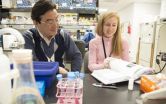(Press-News.org) A new study suggests that people who survived the medieval mass-killing plague known as the Black Death lived significantly longer and were healthier than people who lived before the epidemic struck in 1347.
Caused by the bacteria Yersinia pestis, the Black Death wiped out 30 percent of Europeans and nearly half of Londoners during its initial four-year wave from 1347 – 1351.
Released Wednesday (May 7) in the journal PLOS ONE, the study by University of South Carolina anthropologist Sharon DeWitte provides the first look at how the plague, called bubonic plague today, shaped population demographics and health for generations.
The findings have important implications for understanding emerging diseases and how they impact the health of individuals and populations of people.
"Knowing how strongly diseases can actually shape human biology can give us tools to work with in the future to understand disease and how it might affect us," DeWitte says.
She says the Black Death was a single iteration of a disease that has affected humans since at least the 6th century Plague of Justinian.
"Genetic analysis of 14th century Y. pestis has not revealed significant functional differences in the ancient and modern strains," DeWitte says. "This suggests that we need to consider other factors such as the characteristics of humans in order to understand changes in the disease over time."
To better understand those human factors DeWitte has spent the last decade examining the skeletal remains of more 1,000 men, women and children who lived before, during and after the Black Death. The skeletons, maintained in the archives of the Museum of London, were excavated from a handful of well-documented London cemeteries, including St. Mary Spital, Guildhall Yard, St. Nicholas Shambles and St. Mary Graces.
The skeletons are catalogued in 3-foot by 1-foot boxes. As she studies each skeleton, DeWitte determines biological sex, age at death and analyzes specific markers, including porous lesions, and teeth, to gauge each individual's general health. Her bioarchaeological research is providing a new dimension to the study of Black Death and provides the first look at the lives of women and children during this medieval time period.
"It's innovative because of the analytical approaches I take. I'm providing more nuanced reconstructions of life in the past than is possible with more traditional methods in my field," DeWitte says. "My Black Death research is rare because the samples that I use are exceedingly rare. There are only a handful of large cemetery samples that are clearly linked to the 14th century Black Death.
"And, most medieval historical records only tell about the experience of men. We have little information about the experiences of women and children and the poor in general during medieval plague epidemics, including the Black Death. My bioarchaeological data allows us to understand how the population in general fared during and after the epidemic."
DeWitte's analysis has revealed several important findings. Most notably that:
the 14th-century Black Death was not an indiscriminate killer, but instead targeted frail people of all ages;
survivors of the Black Death experienced improvements in health and longevity, with many people living to ages of 70 or 80 years, as compared to pre-Black Death populations;
improvements in survival post-Black Death didn't necessarily equate to good health over a lifespan, but revealed a hardiness to endure disease, including repeated bouts of plague; and
the Black Death, either directly or indirectly, very powerfully shaped mortality patterns for generations after the epidemic ended.
DeWitte says she was surprised by how much of a change she estimated between the pre- and post-Black Death periods.
"The Black Death was just the first outbreak of medieval plague, so the post-Black Death population suffered major threats to health in part from repeated outbreaks of plague," DeWitte says. "Despite this, I found substantial improvements in demographics and thus health following the Black Death."
In addition to the PLOS ONE journal article, DeWitte has a related article appearing in the current issue of the American Journal of Physical Anthropology.
INFORMATION:
DeWitte will head back to London this month with two graduate students for six weeks to collect further data. Her research is funded by the National Science Foundation, the Wenner-Grenn Foundation, the American Association of Physical Anthropologists and the university's office of the provost.
Editors: Access the PLOS ONE article here: http://www.plosone.org/article/info%3Adoi%2F10.1371%2Fjournal.pone.0096513;jsessionid=D9E694FD319F7112F0FA17DFB32EF69C
New study sheds light on survivors of the Black Death
Findings have important implications for understanding emerging diseases and how they impact the health of individuals and populations of people
2014-05-08
ELSE PRESS RELEASES FROM THIS DATE:
New care approach eases depression among women
2014-05-08
Women who received collaborative care for depression at an obstetrics and gynecology clinic showed fewer symptoms after treatment than women receiving usual depression care in the same setting, recent University of Washington research found.
The collaborative approach comprises counseling and greater patient engagement than is typical of mental health care at specialty clinics. It involves psychiatrists, clinicians, specialists and depression care managers. The team meets weekly to review patient progress and provide treatment recommendations. The care manager follows ...
First-ever study describes deep-sea animal communities around a sunken shipping container
2014-05-08
MOSS LANDING, CA — Thousands of shipping containers are lost from cargo vessels each year. Many of these containers eventually sink to the deep seafloor. In 2004, scientists at the Monterey Bay Aquarium Research Institute (MBARI) discovered a lost shipping container almost 1,300 meters (4,200 feet) below the surface of the Monterey Bay National Marine Sanctuary. In the first-ever survey of its kind, researchers from MBARI and the sanctuary recently described how deep-sea animal communities on and around the container differed from those in surrounding areas.
In February ...
Mouse study offers new clues to cognitive decline
2014-05-08
New research suggests that certain types of brain cells may be "picky eaters," seeming to prefer one specific energy source over others. The finding has implications for understanding the cognitive decline seen in aging and degenerative diseases such as Alzheimer's and multiple sclerosis.
Studying mice, investigators from Washington University School of Medicine in St. Louis showed that a specific energy source called NAD is important in cells responsible for maintaining the overall structure of the brain and for performing complex cognitive functions. NAD (nicotinamide ...
Improving air quality in NYC would boost children's future earnings
2014-05-08
Reducing air pollution in New York City would result in substantial economic gains for children as a result of increasing their IQs. The study is the first to estimate the costs of IQ loss associated with exposure to air pollution, and is based on prior research on prenatal exposure to air pollutants among low-income children by Frederica Perera, PhD, lead author of the current study, and colleagues at the Columbia Center for Children's Environmental Health at the Mailman School of Public Health.
The researchers made their calculation using a hypothesized modest reduction ...
Listening to bipolar disorder: Smartphone app detects mood swings via voice analysis
2014-05-08
ANN ARBOR, Mich. — A smartphone app that monitors subtle qualities of a person's voice during everyday phone conversations shows promise for detecting early signs of mood changes in people with bipolar disorder, a University of Michigan team reports.
While the app still needs much testing before widespread use, early results from a small group of patients show its potential to monitor moods while protecting privacy.
The researchers hope the app will eventually give people with bipolar disorder and their health care teams an early warning of the changing moods that ...
Why a bacterium got its curve -- and why biologists should know
2014-05-08
Drawing from his engineering background, Princeton University researcher Alexandre Persat had a notion as to why the bacteria Caulobacter crescentus are curved — a hunch that now could lead to a new way of studying the evolution of bacteria, according to research published in the journal Nature Communications.
Commonly used in labs to study cell division, C. crescentus naturally take on a banana-like curve, but they also can undergo a mutation in which they grow to be perfectly straight. The problem was that in a laboratory there was no apparent functional difference ...
Population screening for SCD in young people: Feasible with basic screening program
2014-05-08
Amsterdam, 8 May 2014. Despite fears over cost, the wide-scale screening of young people to detect risk of sudden cardiac death (SCD) is feasible and cost effective, according to a study presented at EuroPRevent 2014.(1) More than 12,000 people aged between 14 and 35 were screened at a cost of £35 (40 euro) each; rates of subsequent referral for further investigation were low and considered of "a relative low additional cost" to health services.
The study was reported at the EuroPRevent congress 2014 in Amsterdam by Dr Rajay Narain, Clinical Research Fellow from the Department ...
Adults with autism virtually learn how to get the job
2014-05-08
CHICAGO --- Adults with an autism spectrum disorder, who may have trouble talking about themselves and interacting socially, don't always make good impressions in job interviews and have low employment rates.
A new human simulation training program -- based on software originally used to train FBI agents -- helps adults with autism improve their job interview skills and confidence, reports a new Northwestern Medicine® study.
The new interactive program was designed specifically for adults with psychiatric disorders and was also evaluated for use by adults with autism ...
Hybrid SPECT-CT greatly improves localization of gastrointestinal bleeding
2014-05-08
Leesburg, VA, May 8, 2014—Prompt and accurate localization of the site of bleeding is critical for the management of patients with acute GI bleeding. Planar 99mTc-labeled RBC scintigraphy is sensitive for detection of acute gastrointestinal (GI) bleeding but its accuracy for localization of a bleeding source is arguable, particularly in patients with complex GI anatomy from prior surgeries.
Researchers at the Cleveland Clinic reviewed cases of GI bleeding in patients who had a concurrent hybrid SPECT–CT for evaluating equivocal 99mTc-labeled RBC activity on planar scintigraphy. ...
Gluten-free diet reduces risk of type 1 diabetes in mice
2014-05-08
New experiments on mice show, that mouse mothers can protect their pups from developing type 1 diabetes by eating a gluten-free diet. According to preliminary studies by reseachers at the University of Copenhagen, the findings may apply to humans.
More than 1% of the Danish population has type 1 diabetes, one of the highest incidence rates in the world. New experiments on mice now show a correlation between the health of the pups and their mothers eating a gluten-free diet. Our hope is that the disease may be prevented through simple dietary changes, the researchers say.
"Preliminary ...
LAST 30 PRESS RELEASES:
Routine scans could detect early prostate radiotherapy changes
Fairness in AI: Study shows central role of human decision-making
Pandemic ‘beneath the surface’ has been quietly wiping out sea urchins around the world
Tea linked to stronger bones in older women, while coffee may pose risks
School feeding programs lead to modest but meaningful results
Researchers develop AI Tool to identify undiagnosed Alzheimer's cases while reducing disparities
Seaweed based carbon catalyst offers metal free solution for removing antibiotics from water
Simple organic additive supercharges UV treatment of “forever chemical” PFOA
£13m NHS bill for ‘mismanagement’ of menstrual bleeds
The Lancet Psychiatry: Slow tapering plus therapy most effective strategy for stopping antidepressants, finds major meta-analysis
Body image issues in adolescence linked to depression in adulthood
Child sexual exploitation and abuse online surges amid rapid tech change; new tool for preventing abuse unveiled for path forward
Dragon-slaying saints performed green-fingered medieval miracles, new study reveals
New research identifies shared genetic factors between addiction and educational attainment
Epilepsy can lead to earlier deaths in people with intellectual disabilities, study shows
Global study suggests the underlying problems of ECT patients are often ignored
Mapping ‘dark’ regions of the genome illuminates how cells respond to their environment
ECOG-ACRIN and Caris Life Sciences unveil first findings from a multi-year collaboration to advance AI-powered multimodal tools for breast cancer recurrence risk stratification
Satellite data helps UNM researchers map massive rupture of 2025 Myanmar earthquake
Twisting Spins: Florida State University researchers explore chemical boundaries to create new magnetic material
Mayo Clinic researchers find new hope for toughest myeloma through off-the-shelf immunotherapy
Cell-free DNA Could Detect Adverse Events from Immunotherapy
American College of Cardiology announces Fuster Prevention Forum
AAN issues new guideline for the management of functional seizures
Could GLP-1 drugs affect risk of epilepsy for people with diabetes?
New circoviruses discovered in pilot whales and orcas from the North Atlantic
Study finds increase in risk of binge drinking among 12th graders who use 2 or more cannabis products
New paper-based technology could transform cancer drug testing
Opioids: clarifying the concept of safe supply to save lives
New species of tiny pumpkin toadlet discovered in Brazil highlights need for conservation in the mountain forests of Serra do Quiriri
[Press-News.org] New study sheds light on survivors of the Black DeathFindings have important implications for understanding emerging diseases and how they impact the health of individuals and populations of people




